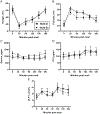Effects of Exercise during Weight Loss Maintenance on Appetite Regulation in Women
- PMID: 33748418
- PMCID: PMC7978467
- DOI: 10.1249/tjx.0000000000000133
Effects of Exercise during Weight Loss Maintenance on Appetite Regulation in Women
Abstract
Exercise is accepted as a method to improve weight loss maintenance; however, the mechanisms by which this occurs have yet to be elucidated. In this pilot study, 13 women with obesity underwent a structured weight loss program (goal 8%-10% weight loss) and were then randomized to either a 12-wk diet (n = 7) or an aerobic exercise training (n = 6) intervention aimed at maintaining weight loss. At baseline, post-weight loss, and following the weight loss maintenance interventions, measurements of appetite (hunger and satiety) and appetite-regulating hormones (leptin, ghrelin, peptide tyrosine tyrosine, and glucagon-like peptide 1) were obtained after an overnight fast and for 3 h after a standardized test meal. Ad libitum energy intake was measured at a lunch meal. During the weight loss phase, participants lost 9.1% ± 1.1% of baseline body weight. Participants in both groups maintained weight loss during the 12-wk weight loss maintenance intervention. No differences in fasting leptin (P = 0.68) or in ghrelin (P = 0.30), peptide tyrosine tyrosine (P = 0.93), and glucagon-like peptide 1 (P = 0.98) area under the curve were detected between groups. Similarly, ratings of hunger (P = 0.99) and satiety (P = 0.65) area under the curve after the standardized test meal also did not differ between the groups nor did ad libitum energy intake at lunch. In summary, the 12-wk diet and exercise interventions were equally effective at maintaining weight loss in women, and no differences in measures of appetite regulation and food intake were found.
Conflict of interest statement
The authors report no conflicts of interest. The results of the present study do not constitute endorsement by the American College of Sports Medicine.
Figures




Similar articles
-
Influence of postexercise fasting on hunger and satiety in adults.Appl Physiol Nutr Metab. 2020 Sep;45(9):1022-1030. doi: 10.1139/apnm-2019-0947. Epub 2020 Apr 9. Appl Physiol Nutr Metab. 2020. PMID: 32272024 Clinical Trial.
-
Appetite and Energy Intake Regulation in Response to Acute Exercise.Med Sci Sports Exerc. 2021 Oct 1;53(10):2173-2181. doi: 10.1249/MSS.0000000000002678. Med Sci Sports Exerc. 2021. PMID: 33831896 Free PMC article. Clinical Trial.
-
Nut-enriched energy restricted diet has potential to decrease hunger in women at cardiometabolic risk: a randomized controlled trial (Brazilian Nuts Study).Nutr Res. 2023 Jan;109:35-46. doi: 10.1016/j.nutres.2022.11.003. Epub 2022 Nov 26. Nutr Res. 2023. PMID: 36577255 Clinical Trial.
-
Appetite regulation in overweight, sedentary men after different amounts of endurance exercise: a randomized controlled trial.J Appl Physiol (1985). 2013 Dec;115(11):1599-609. doi: 10.1152/japplphysiol.00680.2013. Epub 2013 Sep 19. J Appl Physiol (1985). 2013. PMID: 24052035 Clinical Trial.
-
Exercise, appetite and appetite-regulating hormones: implications for food intake and weight control.Ann Nutr Metab. 2010;57 Suppl 2:36-42. doi: 10.1159/000322702. Epub 2011 Feb 22. Ann Nutr Metab. 2010. PMID: 21346335 Review.
Cited by
-
Appetitive and Metabolic Responses to an Exercise versus Dietary Intervention in Adults with Obesity.Transl J Am Coll Sports Med. 2022 Fall;7(4):e000211. doi: 10.1249/tjx.0000000000000211. Epub 2022 Oct 14. Transl J Am Coll Sports Med. 2022. PMID: 36337848 Free PMC article.
References
-
- Sumithran P, Prendergast LA, Delbridge E, et al. Long-term persistence of hormonal adaptations to weight loss. N Engl J Med. 2011;365(17):1597–604. - PubMed
Grants and funding
LinkOut - more resources
Full Text Sources
